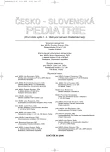Gastroezofágový reflux u detí s bronchiálnou astmou
Gastroesophageal Reflux in Children with Bronchial Asthma
Background:
Gastroesophageal reflux (GER) plays a role in inducing or exacerbating asthma. GER can induce bronchoconstriction by two pathophysiological mechanisms, specifically the reflex and reflux mechanisms.
Objective:
The objective of this study was to test 1) the prevalence of GER in a group of children with asthma, 2) diversity in prevalence of GER between allergic and non-allergic i.e. stable and unstable asthmatic patients, 3) the efficacy of anti-reflux therapy in asthmatics with GER and 4) differences in the efficacy of treatment of allergic and non-allergic patients.
Methods:
The authors evaluated 24 hr esophageal pH monitoring in 116 children (65 boys and 51 girls), aged from 6 to 18 years (median age 10.7 years) and hospitalized in Srobarov institute in the second half year of 2004. Medical history data were collected for each patient and included: 1) presence if any of allergic indicators (asthma of parents, allergy and peripheral blood eosinophils of patients) and 2) stability of regularly treated asthma (presence of diurnal and nocturnal respiratory symptoms). They evaluated asthma outcome before and after anti-GER treatment (lifestyle changes, physiotherapy, dopamine antagonist and antacid therapy for six months).
Results:
The incidence of GER was 59%, it was significant higher in unstable (70%) then in stable asthma (p <0.001). Between allergic (52%) and non - allergic (65%) asthma was no significant difference in the prevalence of GER. Anti-reflux therapy was effective in improving clinical status (p <0.001), pulmonary functions (p <0.001) and improving of GER (p <0.001). Statistically significant differences in improvement were found between non-allergic (p <0.001; 0.001; 0.001, respectively) and allergic (p <0.05; 0.05; 0.01 respectively) asthma, while in non-allergic asthma the improvement was higher (p <0.01).
Conclusions:
The incidence of GER was higher in children with unstable asthma, there were no differences in incidence between allergic and non-allergic types of asthma. Anti-reflux therapy was effective in improving asthma symptoms, pulmonary functions and GER, especially in patients with non-allergic asthma.
Key words:
gastroesophageal reflux (GER), bronchial asthma
Autoři:
A. Tarhini 1; V. Pohanka 2; I. Čierna 1; L. Kovács 1; A. Kapellerová 1
Působiště autorů:
2. Detská klinika LFUK a DFNsP, Bratislava
prednosta prof. MUDr. L. Kovács, DrSc., MPH
1; Šrobárov ústav detskej TaRCH, Dolný Smokovec
riaditeľ doc. MUDr. V. Pohanka, PhD, FCCD, MPH
2
Vyšlo v časopise:
Čes-slov Pediat 2006; 61 (12): 679-683.
Kategorie:
Původní práce
Souhrn
Úvod:
Gastroezofágový reflux (GER) má dôležitú úlohu pri vzniku a exacerbácii bronchiálnej astmy. GER môže vyvolať bronchokonstrikciu dvoma patofyziologickými mechanizmami, t.j. reflexným a refluxným mechanizmom.
Ciele:
Cieľom tejto štúdie bolo zistiť prevalenciu GER v skupine detí s alergickou, resp. nealergickou astmou a hodnotiť efektívnosť anti-refluxnej terapie u astmatikov s GER.
Metódy:
24-hodinová pH metria sa uskutočnila u 116 detí (65 chlapcov a 51 dievčat) s bronchiálnou astmou vo veku 6–18 rokov (priemerný vek 10,7 r.) hospitalizovaných v Šrobárovom ústave za druhý polrok 2004. V rámci anamnézy boli zaznamenávané: prítomnosť alergickej anamnézy (astma u rodičov, alergické prejavy a eozinofília u pacienta) a stabilizácia regulárne liečenej astmy (prítomnosť dennej a nočnej respiračnej symptomatológie). Hodnotil sa stav astmy pred a po anti-refluxnej liečbe (zmena životosprávy, fyzioterapia, antagonisti dopaminu a antacída po dobu šesť mesiacov).
Výsledky:
Prevalencia GER bola 59 %, pritom bola významne vyššia u nestabilizovaných (70 %) ako u stabilizovaných astmatikov (43 %) (p <0,001). Medzi pacientami s alergickou (52 %) a nealergickou (65 %) astmou nie je signifikantný rozdiel v prevalencii GER. Anti-refluxná terapia viedla k zlepšeniu klinického stavu (p <0,01), dýchacích funkcií (p <0,001) ako aj ústupu GER (p <0,001). Štatistický rozdiel uvedených parametrov bol zistený aj u nealergikov (p <0,001; 0,001; 0,001 resp.), v porovnaní s alergickými (p <0,05; 0,05; 0,01 resp.) astmatikmi bolo zlepšenie u pacientov s nealergickou astmou signifikantne významnejšie (p <0,01).
Záver:
Prevalencia GER je vyššia u detí s nestabilizovanou astmou, medzi alergickými a nealergickými neboli zistené významné rozdiely. Anti-refluxná terapia bola efektívna pri zlepšení symptómov astmy, pľúcnych funkcií a GER, najmä u nealergických astmatikov.
Kľúčové slová:
gastroezofágový reflux (GER), bronchiálna astma
Štítky
Neonatologie Pediatrie Praktické lékařství pro děti a dorostČlánek vyšel v časopise
Česko-slovenská pediatrie

2006 Číslo 12
- Horní limit denní dávky vitaminu D: Jaké množství je ještě bezpečné?
- Isoprinosin je bezpečný a účinný v léčbě pacientů s akutní respirační virovou infekcí
- Orální lichen planus v kostce: Jak v praxi na toto multifaktoriální onemocnění s různorodými symptomy?
Nejčtenější v tomto čísle
- Segmentální neurofibromatóza (von Recklinghausenova choroba)
- Gastroezofágový reflux u detí s bronchiálnou astmou
- Spolupráce dětského zubního lékaře a anesteziologa při ošetřování dětí v celkové anestezii
- Problémy v diagnostice cystické fibrózy – potřeba novorozeneckého screeningu Přehledový článek o aktuálních problémech
